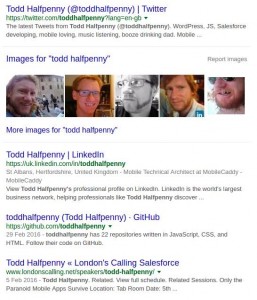Is it a bird? Is it a plane? No! It’s a Salesforce Ladies in Tech and Developer Super Meetup!
That’s right, the March meetup of the London Salesforce Developers joined forces with the Salesforce Ladies in Tech to hold a combined super-gathering.
The Brightgen offices in Salesforce Tower hosted us, and as ever I was dead pleased to ride in the outside elevator up to their amazing view over the city. And I was in great company on my way up, joined by both Jodi Wagner – one of the night’s speakers and all round Salesforce celeb – and the MobileCaddy CEO, Justin Halfpenny. Not only is he our CEO, but he’s also my brother and the latest member of the community to put their names forward to co-organise the London Salesforce DUG.
The evening was to have two talks, one from each of the meetup groups… but of course it started with a natter and a drink. Seriously, if you’ve not been to a meetup then I can’t recommend you attend enough. Even without the presentations they’re an incredible source of business and geek chat, and the odd slice of pizza.
Personal Branding – Jodi Wagner
First up was Jodi. She’s an incredibly active and passionate member of the community. Not only is she a co-organiser of the Salesforce Women in Tech meetup but she also co-organised the incredible London’s Calling and the recent Evening with Ladies who Salesforce. Oh, she’s also a delivery manager at Accenture, if she wasn’t busy enough already.
Jodi’s talk was all about personal branding, and she started with something that I hadn’t even begun to appreciate, and that’s the thought that personal branding isn’t about you, it’s about other’s perceptions of you. She recommended that, however vain it might be, it’s a good idea to google yourself. I did, and I was pleasantly relieved/surprised (delete as appropriate).

Once you know where you currently stand you then need to think about your Value Proposition, and where you want to be. Jodi has many suggestions around how to get there, and you can find all the details in her slides. Some key areas mentioned though include;
- Planning
- Know the channels – what you post on LinkedIn won’t necessarily work in your favour on Facebook, for example
- Keep a schedule in mind – when are your target audience online
- Monitor the results – tools can be used to see the reach and impact of your work.
A really nice touch to Jodi’s talk was a slide containing a few tips from some of the folk within the Salesforce ecosystem who appear to have mastered their online branding. A couple of messages seem to come through strongly, such as “Be authentic” and “Be consistent”, the latter could apply to message and cadence.
I had asked Jodi about whether or not she thought it was a good idea to have a personal account, as well as one for your professional self. She replied that if you get the balance right then a single account can be very strong; it was nice to hear her say that from my tweets and blogs that she knew that MobileCaddy was doing some incredible work with offline Salesforce apps, but also that I like food and go for a jog every now and again… I’ll take that.
Open Source & Apex Common and Apex Mocks
The next talk was actually in two parts, let’s respect that; The talks were by Andrew Fawcett and David Frudd of FinancialForce.
Getting the most out of the Salesforce Open Source Community
Salesforce has been notable of late in the Open Source world following its release of the Lightning Design System, but there are many more Salesforce (initiated and related) open source projects than that, and some have been around for quite some time. MobileCaddy are keen open source contributors too, not only into our own projects such as our mobile starter apps, but also the Salesforce Mobile SDK projects that we extend to provide fully offline mobile apps with custom UIs. We also contribute to other projects such as ngCordova and Ionic that help provide support for incredible hybrid mobile applications.
Andrew talked us through things of note to look out for when contemplating whether or not to contribute (or even use) open source projects, though more of interest to me was what you can get out of it. He spoke about how FinancialForce’s open source projects had helped them with;
- Recruitment
- Product Promotion
- Social/ethical Rewards
What’s new in FinancialForce Apex-Common and Apex-Mocks?
Andrew’s colleague David was up next to talk about two of FinancialForce’s projects. Apex Common and Apex Mocks are two projects that we use and love at MobileCaddy and David gave us an explanation of each, and some of the new(ish) features and fixes that had been contributed not only by FinancialForce employees but also the wider open source community.
The fflib-apex-common repo gives you a wonderful project that aids Apex developers by giving them a best practice and practical design patterns library for use within their Salesforce applications. One can combine the beautiful modular code you get from using this library with the fflib-apex-mocks repo to achieve great coverage in your unit tests too.
For information and examples and tutorials on using these, and the other FinancialForce projects head over to their developer site.
Wrap Up
It was really nice to share the meetup with the Ladies in Tech, and I hope it’s something we get to do again. I’d love to have chatted to some of the other attendees more, but time as always was not on our side.
Videos of the evening’s talks should be available on the meetup’s YouTube channel (soon if not already there).
Thanks, as usual, to the organisers and sponsors.
The next meetup should fall on the 25th May, less than a week after the London edition of the Salesforce World Tour. I hope to be at the meetup if manning our sponsorship booth at the World Tour doesn’t prove too much for me. UPDATE: the meetup has moved to the 17th May – Developing Wave Apps with Skip Sauls, hope to see you there!
And if you are planning on coming to the World Tour in London then drop by our sponsor booth and check out some of the apps we’ve built for, and with, our partners, and how you too can realise the mobile advantage of taking the power of the platform with you.
